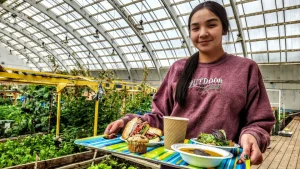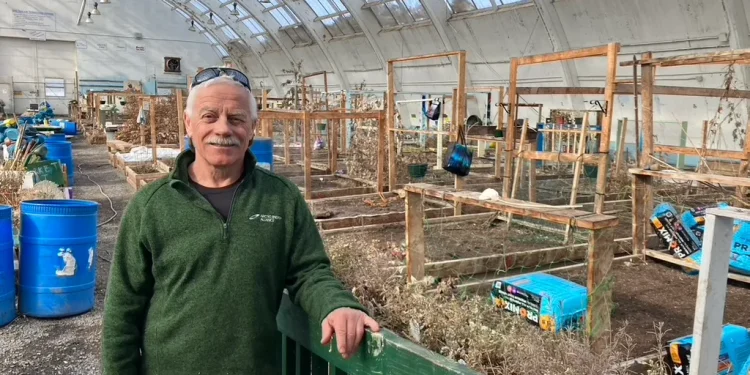Inuvik, a vibrant town in the Arctic Circle, has recently expanded its community greenhouse with the opening of a new café. This exciting addition offers residents a unique opportunity to enjoy fresh, locally-grown produce in a welcoming and affordable environment. With a menu that changes weekly based on the greenhouse’s harvest, the café aims to provide both nutritious food and a new social space for the community.
A New Chapter for Inuvik’s Community Greenhouse
The Inuvik Community Greenhouse, which began its life as a hockey arena at Grollier Hall Residential School, has been a cornerstone of the community for 25 years. In 1998, local residents saved the building from demolition and transformed it into a greenhouse, fostering a space for growing vegetables, herbs, and fostering community connections. The greenhouse’s mission has always been about more than just food production; it is a community space where people can gather, share skills, and build relationships.
Peter Clarkson, a founding member of the greenhouse, reflects on the transformation of the space over the years. “The real benefit of the greenhouse is the social aspect—people visiting, kids in the dirt, families coming in. We’ve really had an open-door policy where we actually literally leave the door open,” he says. This inclusive environment has been central to the greenhouse’s success and has laid the groundwork for its latest venture.
Introducing the Greenhouse Café
The newly opened café, which began operations in early July 2024, is designed to offer a garden-inspired menu that makes the most of the greenhouse’s fresh produce. Alissa Sallans, the greenhouse manager, is excited about the café’s potential. “The food served at the café will harness the output of the building’s herb gardens and market plots,” she explains. Currently, the café features dishes such as Caesar salad made with greenhouse-grown lettuce, and future menus will include seasonal vegetables like peas and zucchini as they come into harvest.
The café’s concept goes beyond just serving food; it is meant to be a communal space where residents can enjoy a meal, play board games, or read a book. Sallans highlights the café’s role in addressing a local need: “There’s a lack of these spaces in town and community spaces that are low-cost. Having a space where you can come with your kids and play some board games, read some books— we’re super excited for that to happen.”
A Platform for Local Artisans and Community Events
In addition to the café, the greenhouse continues to host the Arctic Market on Wednesdays, where local artisans sell crafts and other goods. This market is a vibrant community event that supports local artists and provides a platform for residents to connect and engage with one another.
“The whole social network of people visiting is incredible,” says Clarkson. “People come after work, have a little visit, tend their little plot. It’s about creating a space where people feel welcome to come in, have a coffee, and enjoy the space.”
Sustainability and Future Growth
The greenhouse’s new café and ongoing community events reflect a commitment to sustainability and local engagement. The café not only provides fresh, healthy food but also serves as a model for integrating local produce into everyday life. By offering a space for community interaction and providing a venue for local markets, the café supports both environmental sustainability and social well-being.
Looking Ahead
As the greenhouse café establishes itself as a key part of Inuvik’s community fabric, it represents a successful example of how agricultural spaces can be repurposed and expanded to serve broader community goals. The café’s emphasis on fresh, local produce and its role as a social hub illustrate the potential for greenhouses to contribute positively to both local economies and community life.
Investors and entrepreneurs interested in the agricultural sector may find inspiration in the Inuvik Community Greenhouse’s approach. The integration of a café into a community greenhouse highlights opportunities for blending food production with community-building initiatives. It also underscores the value of creating multi-functional spaces that serve both economic and social purposes.











